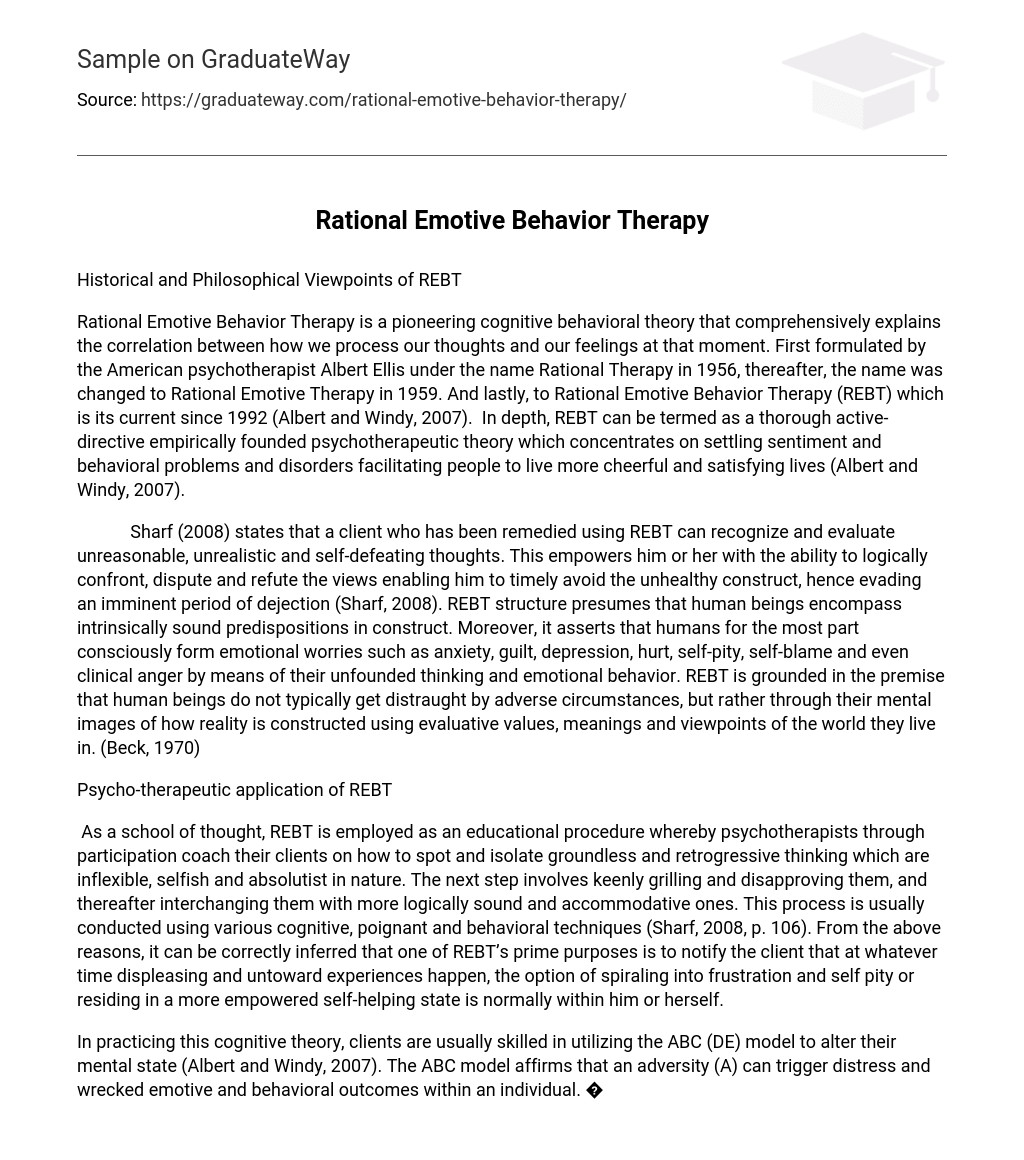Historical and Philosophical Viewpoints of REBT
Rational Emotive Behavior Therapy is a pioneering cognitive behavioral theory that comprehensively explains the correlation between how we process our thoughts and our feelings at that moment. First formulated by the American psychotherapist Albert Ellis under the name Rational Therapy in 1956, thereafter, the name was changed to Rational Emotive Therapy in 1959. And lastly, to Rational Emotive Behavior Therapy (REBT) which is its current since 1992 (Albert and Windy, 2007). In depth, REBT can be termed as a thorough active-directive empirically founded psychotherapeutic theory which concentrates on settling sentiment and behavioral problems and disorders facilitating people to live more cheerful and satisfying lives (Albert and Windy, 2007).
Sharf (2008) states that a client who has been remedied using REBT can recognize and evaluate unreasonable, unrealistic and self-defeating thoughts. This empowers him or her with the ability to logically confront, dispute and refute the views enabling him to timely avoid the unhealthy construct, hence evading an imminent period of dejection (Sharf, 2008).
REBT structure presumes that human beings encompass intrinsically sound predispositions in construct. Moreover, it asserts that humans for the most part consciously form emotional worries such as anxiety, guilt, depression, hurt, self-pity, self-blame and even clinical anger by means of their unfounded thinking and emotional behavior. REBT is grounded in the premise that human beings do not typically get distraught by adverse circumstances, but rather through their mental images of how reality is constructed using evaluative values, meanings and viewpoints of the world they live in. (Beck, 1970)
Psycho-therapeutic application of REBT
As a school of thought, REBT is employed as an educational procedure whereby psychotherapists through participation coach their clients on how to spot and isolate groundless and retrogressive thinking which are inflexible, selfish and absolutist in nature. The next step involves keenly grilling and disapproving them, and thereafter interchanging them with more logically sound and accommodative ones. This process is usually conducted using various cognitive, poignant and behavioral techniques (Sharf, 2008, p. 106).
From the above reasons, it can be correctly inferred that one of REBT’s prime purposes is to notify the client that at whatever time displeasing and untoward experiences happen, the option of spiraling into frustration and self pity or residing in a more empowered self-helping state is normally within him or herself.
In practicing this cognitive theory, clients are usually skilled in utilizing the ABC (DE) model to alter their mental state (Albert and Windy, 2007). The ABC model affirms that an adversity (A) can trigger distress and wrecked emotive and behavioral outcomes within an individual. This adversity in essence could be for example a rowdy mob of soccer fans shouting at night in the vicinity of your residence subsequently interrupting your sleep.
In addition to adversity, the ABC model also lists ones beliefs (B) concerning the adversity as an imperative dynamic that can persuade the emotions succeeding the activating event. In the above example, this belief could be the unfounded view that nothing in this world has the right to interfere with your slumber. The sudden occurrence of a challenging adversity (A), combined with disparaging beliefs (B) can lead to an unfavorable consequence (C), which could either be external or internal (Albert and Windy, 2007).
To increase and substantiate the effectiveness of this behavior modification model a D and an E were later added to the original AB and C (Sharf, 2008). The D abbreviates Dispute; this insinuates that you are entailed to dispute the irrational beliefs by probing them and forwarding more rational alternatives. For instance, why shouldn’t the football hooligans make noise? Is there an implicit law that states this?
The final abbreviation E embodies an Effective new thinking. This is a constructive new notion that is devised specifically to appreciate the state of circumstances. For instance, the hooligans probably mean no ill; their noise is just but a normal product of their passion for the sport (Sharf, 2008). Having reached E, a client shall have finally processed his or her thoughts and feelings in a positive manner; adding life into client’s days.
References
- Albert, E. & Windy, P. (2007). The Practice of Rational Emotive Behavior Therapy: New York, Routlegde.
- Beck A. (1970) Cognitive Therapy: Nature and Relation to Behavior Therapy: Prometheus books
- Sharf, R. (2008), Theories of Counseling and psychotherapy and counseling: Cases and Concepts, Belmont, CA.





